Question
AddressToLatLon.m %% %% AddressToLatLon %% %% Given a street address, returns (latitude, longitude). %% %% Example: %% [lat, lon] = AddressToLatLon('851 S. Morgan St, Chicago
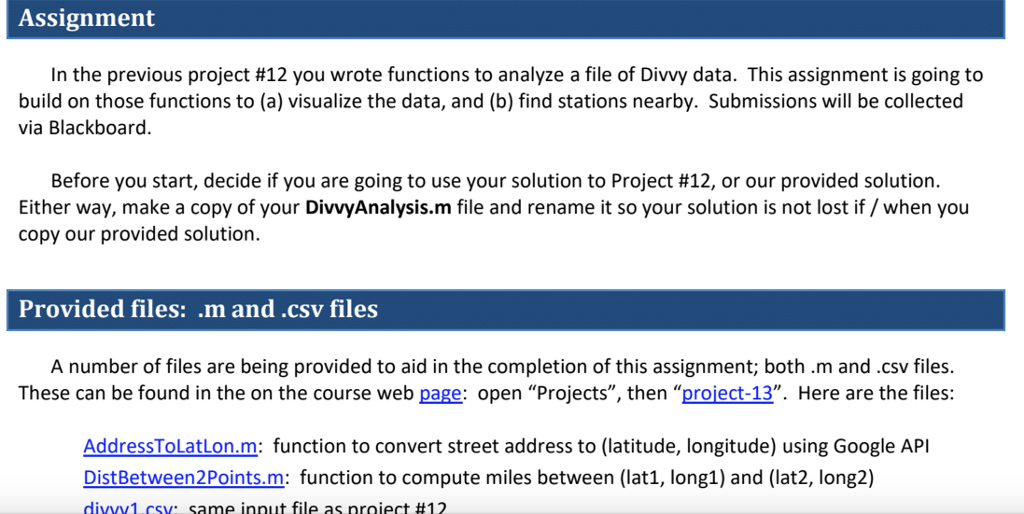
 AddressToLatLon.m
AddressToLatLon.m
%%
%% AddressToLatLon
%%
%% Given a street address, returns (latitude, longitude).
%%
%% Example:
%% [lat, lon] = AddressToLatLon('851 S. Morgan St, Chicago IL');
%%
%%
%% References:
%% https://www.mathworks.com/matlabcentral/fileexchange/24126-google-geocode-api
%% https://www.mathworks.com/matlabcentral/fileexchange/20565-json-parser
%%
%%
function [lat,lon] = AddressToLatLon(address)
retries = 3;
while retries > 0
try
%% try to get (latitude, longitude) from google:
address = strrep(address, ' ', '%20');
google = ['https://maps.googleapis.com/maps/api/geocode/json?address=',address];
result = parse_json(urlread(google));
lat = result{1}.results{1}.geometry.location.lat;
lon = result{1}.results{1}.geometry.location.lng;
break; %% success, break out of the loop
catch ME
%% it failed, let's try again (at most 3 times):
retries = retries - 1;
lat = 0;
lon = 0;
pause(1.0); %% wait 1 second before trying again:
end
end
end
function [data json] = parse_json(json)
% [DATA JSON] = PARSE_JSON(json)
% This function parses a JSON string and returns a cell array with the
% parsed data. JSON objects are converted to structures and JSON arrays are
% converted to cell arrays.
%
% Example:
% google_search = 'http://ajax.googleapis.com/ajax/services/search/web?v=1.0&q=matlab';
% matlab_results = parse_json(urlread(google_search));
% disp(matlab_results{1}.responseData.results{1}.titleNoFormatting)
% disp(matlab_results{1}.responseData.results{1}.visibleUrl)
data = cell(0,1);
while ~isempty(json)
[value json] = parse_value(json);
data{end+1} = value; %#ok
end
end
function [value json] = parse_value(json)
value = [];
if ~isempty(json)
id = json(1);
json(1) = [];
json = strtrim(json);
switch lower(id)
case '"'
[value json] = parse_string(json);
case '{'
[value json] = parse_object(json);
case '['
[value json] = parse_array(json);
case 't'
value = true;
if (length(json) >= 3)
json(1:3) = [];
else
ME = MException('json:parse_value',['Invalid TRUE identifier: ' id json]);
ME.throw;
end
case 'f'
value = false;
if (length(json) >= 4)
json(1:4) = [];
else
ME = MException('json:parse_value',['Invalid FALSE identifier: ' id json]);
ME.throw;
end
case 'n'
value = [];
if (length(json) >= 3)
json(1:3) = [];
else
ME = MException('json:parse_value',['Invalid NULL identifier: ' id json]);
ME.throw;
end
otherwise
[value json] = parse_number([id json]); % Need to put the id back on the string
end
end
end
function [data json] = parse_array(json)
data = cell(0,1);
while ~isempty(json)
if strcmp(json(1),']') % Check if the array is closed
json(1) = [];
return
end
[value json] = parse_value(json);
if isempty(value)
ME = MException('json:parse_array',['Parsed an empty value: ' json]);
ME.throw;
end
data{end+1} = value; %#ok
while ~isempty(json) && ~isempty(regexp(json(1),'[\s,]','once'))
json(1) = [];
end
end
end
function [data json] = parse_object(json)
data = [];
while ~isempty(json)
id = json(1);
json(1) = [];
switch id
case '"' % Start a name/value pair
[name value remaining_json] = parse_name_value(json);
if isempty(name)
ME = MException('json:parse_object',['Can not have an empty name: ' json]);
ME.throw;
end
data.(name) = value;
json = remaining_json;
case '}' % End of object, so exit the function
return
otherwise % Ignore other characters
end
end
end
function [name value json] = parse_name_value(json)
name = [];
value = [];
if ~isempty(json)
[name json] = parse_string(json);
% Skip spaces and the : separator
while ~isempty(json) && ~isempty(regexp(json(1),'[\s:]','once'))
json(1) = [];
end
[value json] = parse_value(json);
end
end
function [string json] = parse_string(json)
string = [];
while ~isempty(json)
letter = json(1);
json(1) = [];
switch lower(letter)
case '\' % Deal with escaped characters
if ~isempty(json)
code = json(1);
json(1) = [];
switch lower(code)
case '"'
new_char = '"';
case '\'
new_char = '\';
case '/'
new_char = '/';
case {'b' 'f' 'n' 'r' 't'}
new_char = sprintf('\%c',code);
case 'u'
if length(json) >= 4
new_char = sprintf('\\u%s',json(1:4));
json(1:4) = [];
end
otherwise
new_char = [];
end
end
case '"' % Done with the string
return
otherwise
new_char = letter;
end
% Append the new character
%%string = [string char(new_char)]; %#ok
string = strcat(string, char(new_char));
end
end
function [num json] = parse_number(json)
num = [];
if ~isempty(json)
% Validate the floating point number using a regular expression
[s e] = regexp(json,'^[\w]?[-+]?[0-9]*\.?[0-9]+([eE][-+]?[0-9]+)?[\w]?','once');
if ~isempty(s)
num_str = json(s:e);
json(s:e) = [];
num = str2double(strtrim(num_str));
end
end
end
DistBetween2Points.m
%%
%% Returns the distance in miles between 2 points
%% (lat1, lon1) and (lat2, lon2). One set must
%% be a point, however the other can be a single
%% point OR a vector --- in which case a vector
%% of distances is returned.
%%
%%
function Distance = DistBetween2Points(lat1, lon1, lat2, lon2)
%%
%% Reference: http://www8.nau.edu/cvm/latlon_formula.html
%%
earth_rad = 3963.1; %% statue miles:
lat1_rad = lat1 .* pi ./ 180.0;
lon1_rad = lon1 .* pi ./ 180.0;
lat2_rad = lat2 .* pi ./ 180.0;
lon2_rad = lon2 .* pi ./ 180.0;
%% distance between points in statue miles:
Distance = earth_rad .* acos(...
(cos(lat1_rad).*cos(lon1_rad).*cos(lat2_rad).*cos(lon2_rad)) ...
+ ...
(cos(lat1_rad).*sin(lon1_rad).*cos(lat2_rad).*sin(lon2_rad)) ...
+ ...
(sin(lat1_rad).*sin(lat2_rad)) ...
);
end
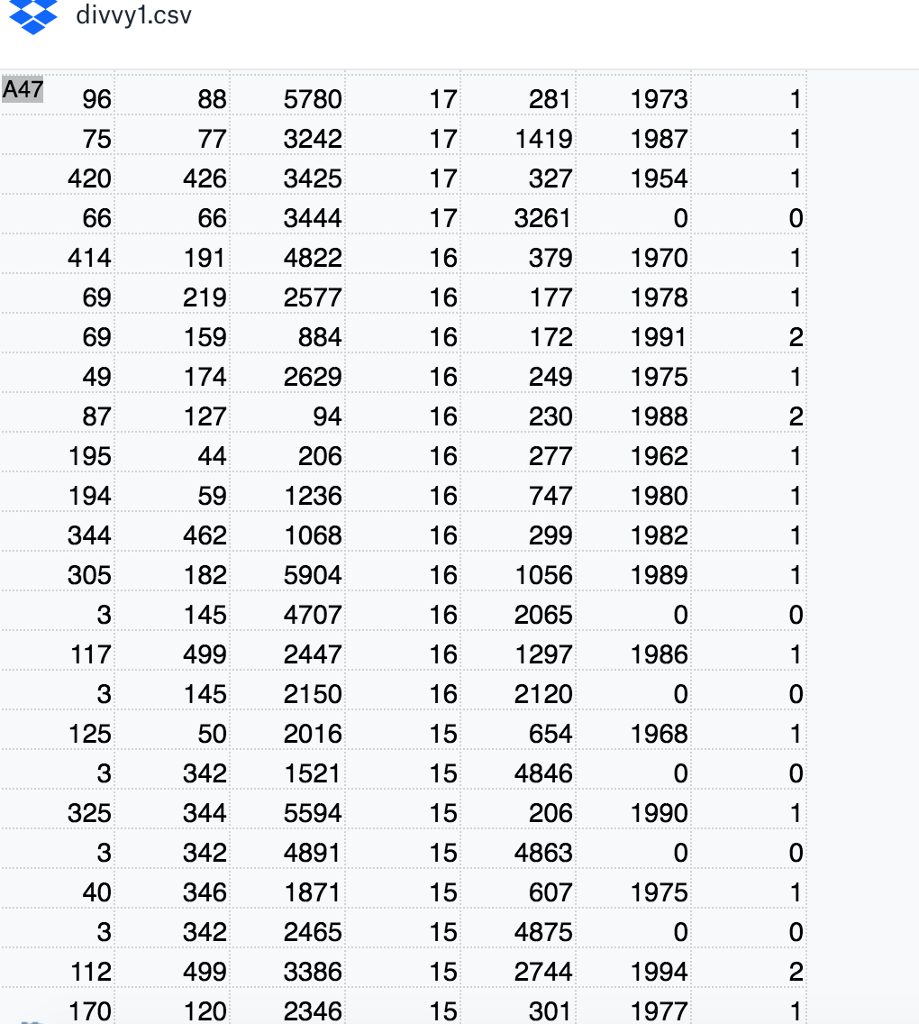
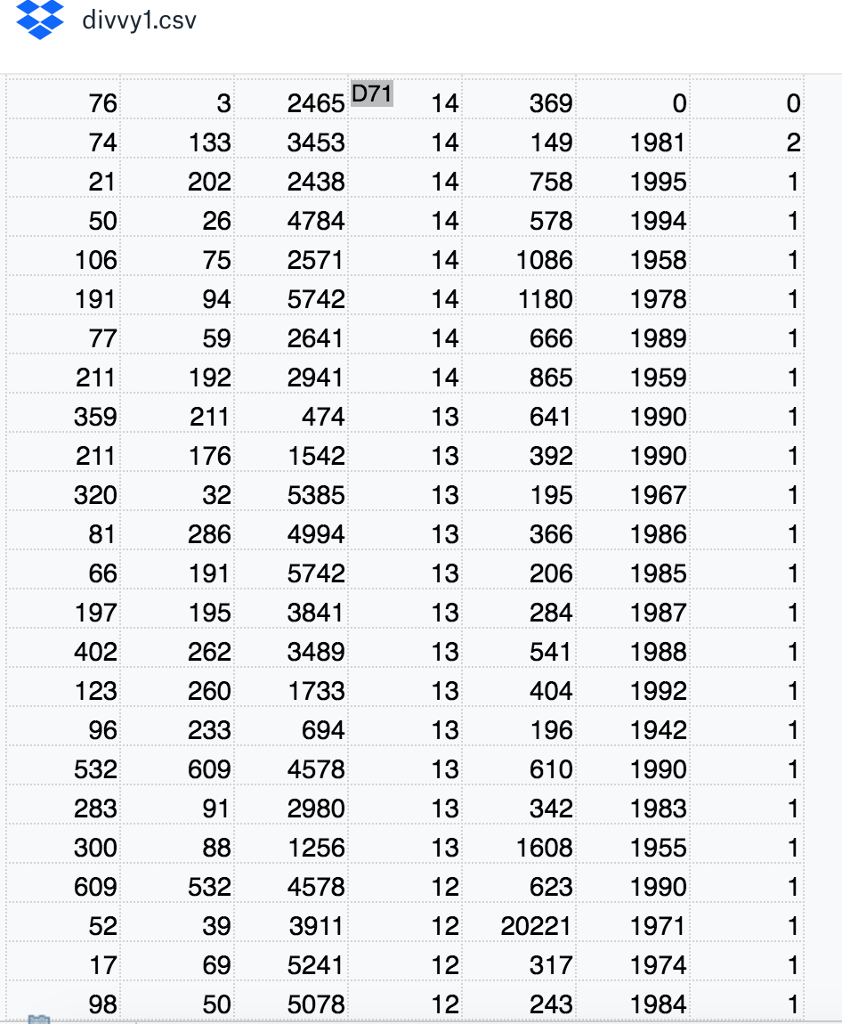
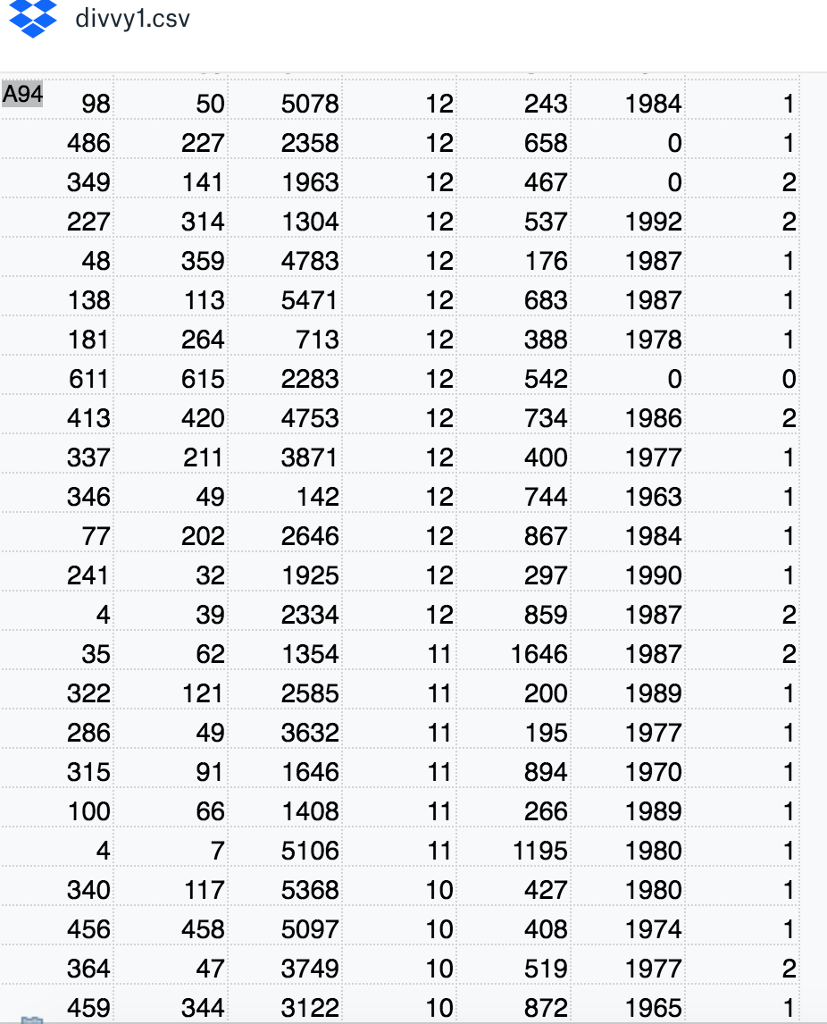
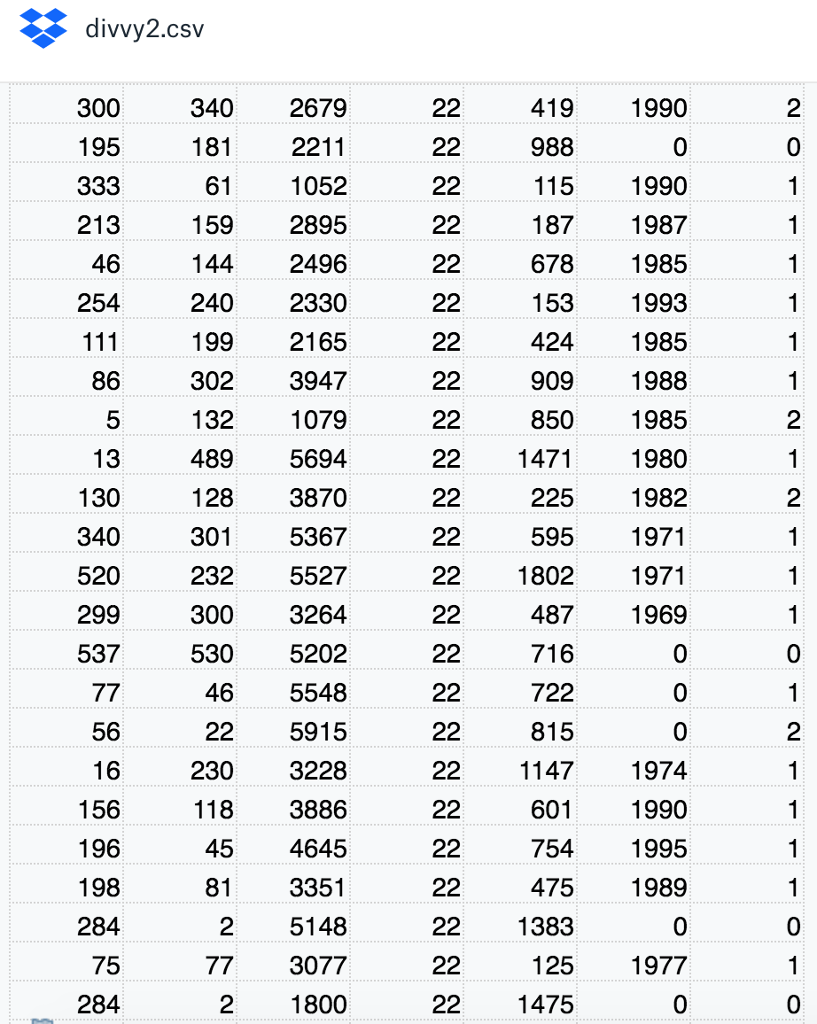
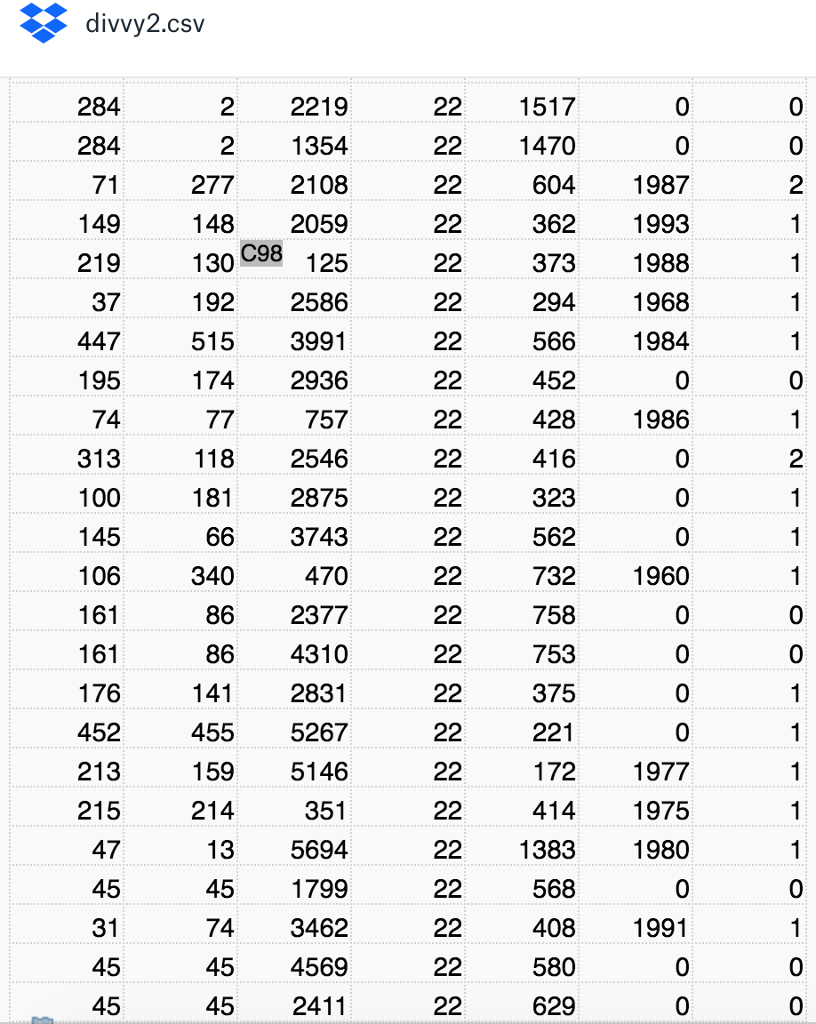
DivvyAnalysis.m
function Result = DivvyAnalysis(filename, analysis, optional)
%%
%% let's make sure the file exists:
%%
if exist(filename, 'file') ~= 2
fprintf('**Error: file "%s" cannot be found ', filename);
Result = '**Error: file not found';
return;
end
%%
%% Load the data:
%%
data = load(filename);
%%
%% Perform requested analysis:
%%
if analysis == 1
Result = NumRides(data);
elseif analysis == 2
Result = AverageRide(data);
elseif analysis == 3
Result = RiderPercentage(data, optional);
elseif analysis == 4
Result = AverageAge(data, optional);
elseif analysis == 5
Result = RideHistogram(data, optional);
elseif analysis == 6
Result = StationCheckouts(data, optional);
elseif analysis == 7
Result = StationCheckins(data, optional);
elseif analysis == 8
Result = Top10Checkouts(data);
elseif analysis == 9
Result = Top10Checkins(data);
else
Result = '**Error: invalid analysis parameter';
end
end
%% total # of rides in this dataset:
function Rides = NumRides(data)
[Rides, ~] = size(data);
end
%% average ride duration, in seconds:
function AvgRide = AverageRide(data)
AvgRide = mean(data(:, 5)); %% trip duration in column 5:
AvgRide = AvgRide / 60.0; %% convert to mins:
end
%% percentage of male (1) or female (2) riders:
function Percentage = RiderPercentage(data, gender)
LI = (data(:, 7) == gender);
Riders = NumRides(data);
Percentage = (sum(LI) / Riders) * 100.0;
end
%% average age of male (1) or female (2) riders:
function AvgAge = AverageAge(data, gender)
LI = ((data(:, 6) > 0) & (data(:, 7) == gender));
birthyears = data(LI, 6); %% extract matching gender with birthyears > 0
%% compute age of rider:
c = clock();
currentyear = c(1); %% year is first entry:
Ages = currentyear - birthyears;
AvgAge = mean(Ages);
end
%% # of rides each hour from midnight to 11pm; pass 0 as "gender" to
%% count all rides, otherwise 1 => male and 2 => female:
function Result = RideHistogram(data, gender)
startingHours = data(:, 4); %% column 4 contains starting hour:
if gender == 0 %% count ALL rides:
Result = histc(startingHours, 0:23); %% 24 bins, 0:23
else
LI = (data(:, 7) == gender); %% search for matching gender:
startingHours = startingHours(LI); %% extract matching rows:
Result = histc(startingHours, 0:23); %% 24 bins, 0:23
end
Result = Result'; %% we want a row vector:
end
%% total # of rides where the ride started at this station:
function Checkouts = StationCheckouts(data, stationID)
LI = (data(:, 1) == stationID); %% column 1 contains starting station:
Checkouts = sum(LI);
end
%% total # of rides where the ride ended at this station:
function Checkins = StationCheckins(data, stationID)
LI = (data(:, 2) == stationID); %% column 2 contains ending station:
Checkins = sum(LI);
end
%% which stations have the largest # of rides that originated here? Return
%% a 10x2 matrix where column 1 are the top-10 station ids and column 2 are
%% the corresponding # of rides starting from these stations:
function Result = Top10Checkouts(data)
ids = data(:, 1); %% column 1 contains starting station IDs:
ids = unique(ids); %% eliminate duplicates:
%%
%% loop can be replaced with histc(data(:, 1), ids);
%%
counts = zeros(length(ids), 1); %% column of 0's
for i = 1:length(ids)
LI = (data(:, 1) == ids(i));
counts(i) = sum(LI);
end
[counts, newOrdr] = sort(counts, 'descend');
ids = ids(newOrdr); %% reorder ids to match:
Result = [ids(1:10), counts(1:10)]; %% top-10 of each:
end
%% which stations have the largest # of rides that ended here? Return
%% a 10x2 matrix where column 1 are the top-10 station ids and column 2 are
%% the corresponding # of rides ending at these stations:
function Result = Top10Checkins(data)
ids = data(:, 2); %% column 2 contains ending station IDs:
ids = unique(ids); %% eliminate duplicates:
%%
%% loop can be replaced with histc(data(:, 1), ids);
%%
counts = zeros(length(ids), 1); %% column of 0's
for i = 1:length(ids)
LI = (data(:, 2) == ids(i));
counts(i) = sum(LI);
end
[counts, newOrdr] = sort(counts, 'descend');
ids = ids(newOrdr); %% reorder ids to match:
Result = [ids(1:10), counts(1:10)]; %% top-10 of each:
end
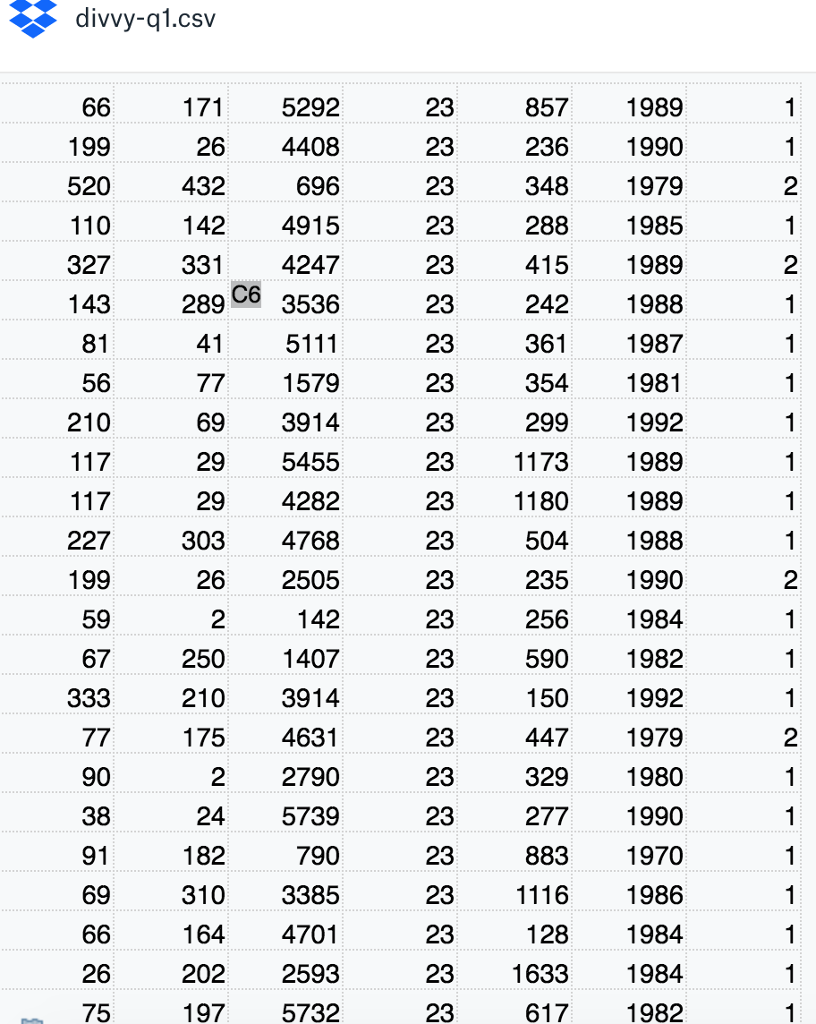
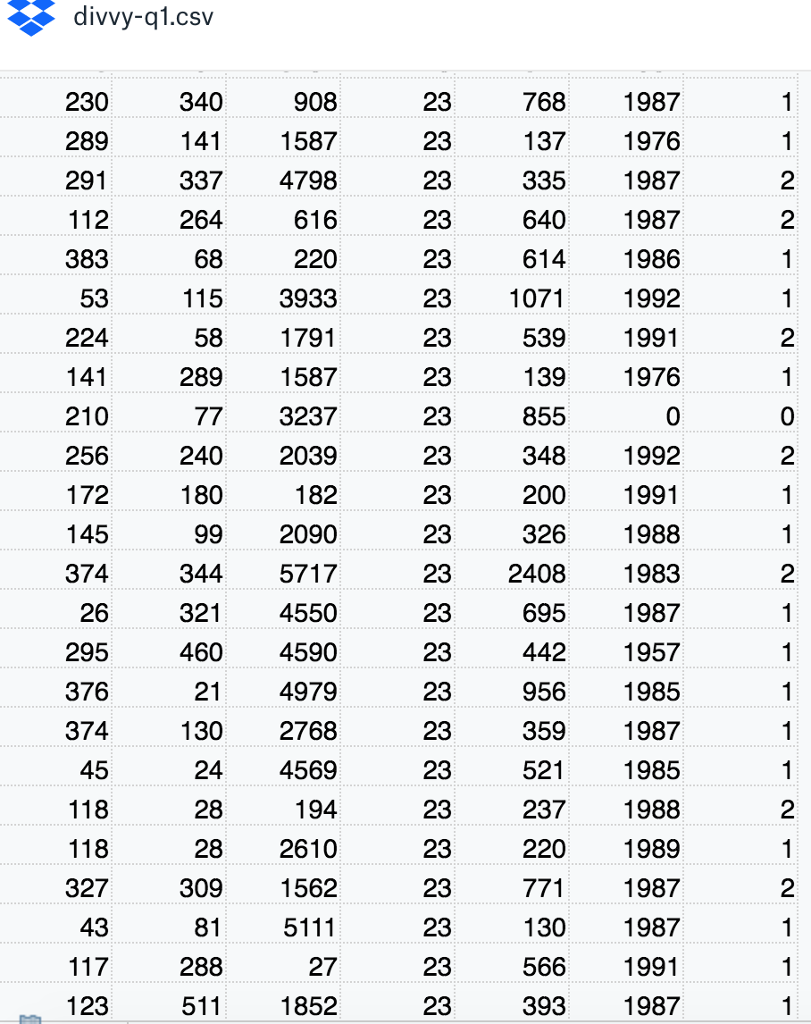
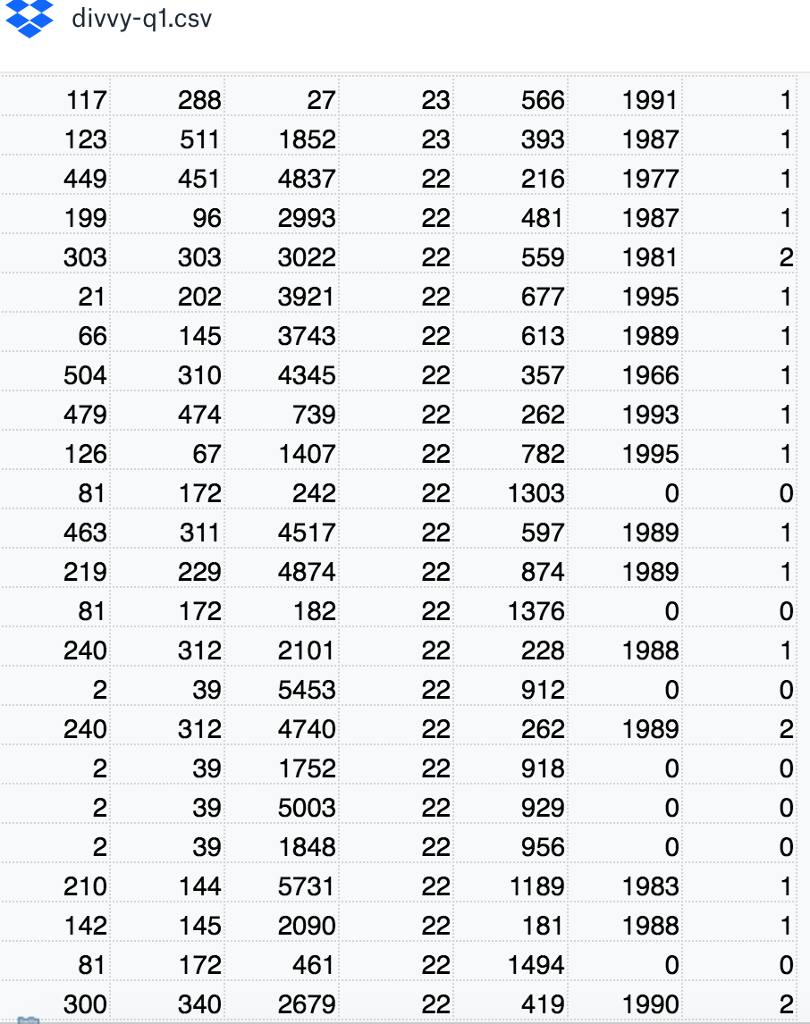
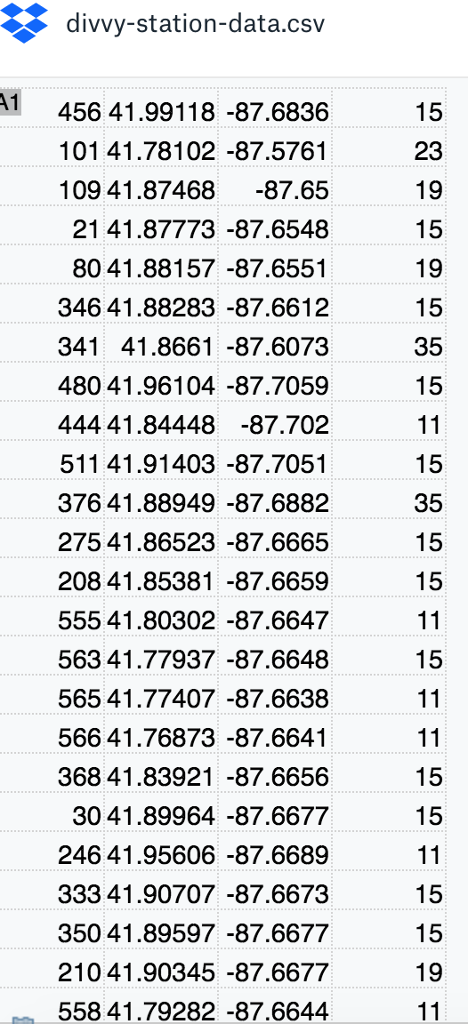
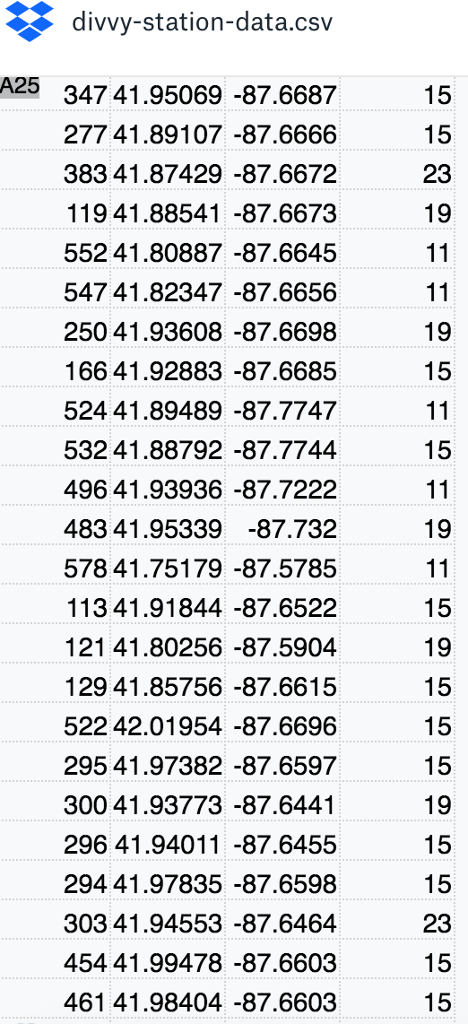
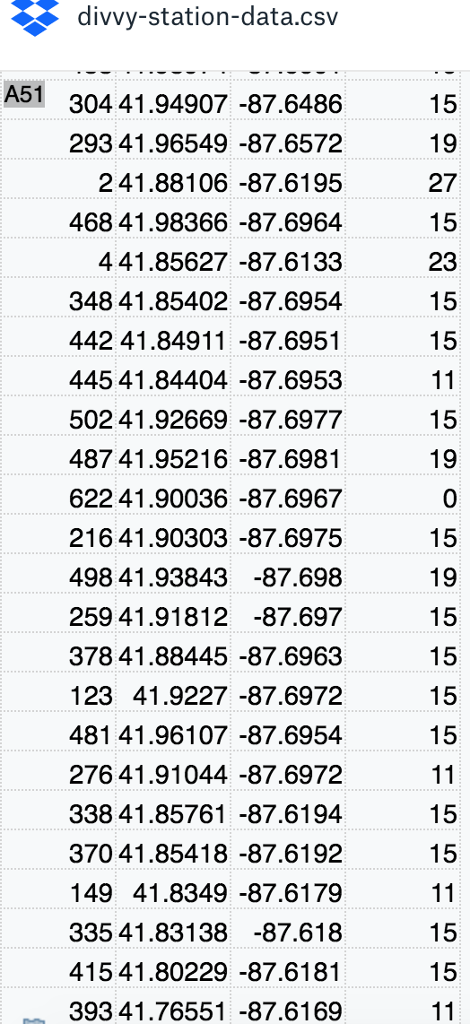
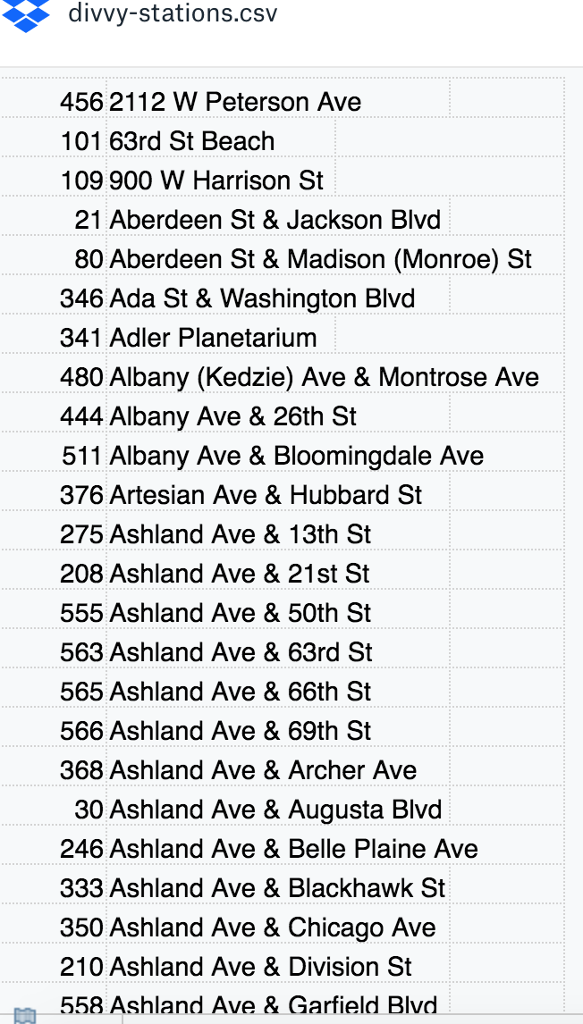

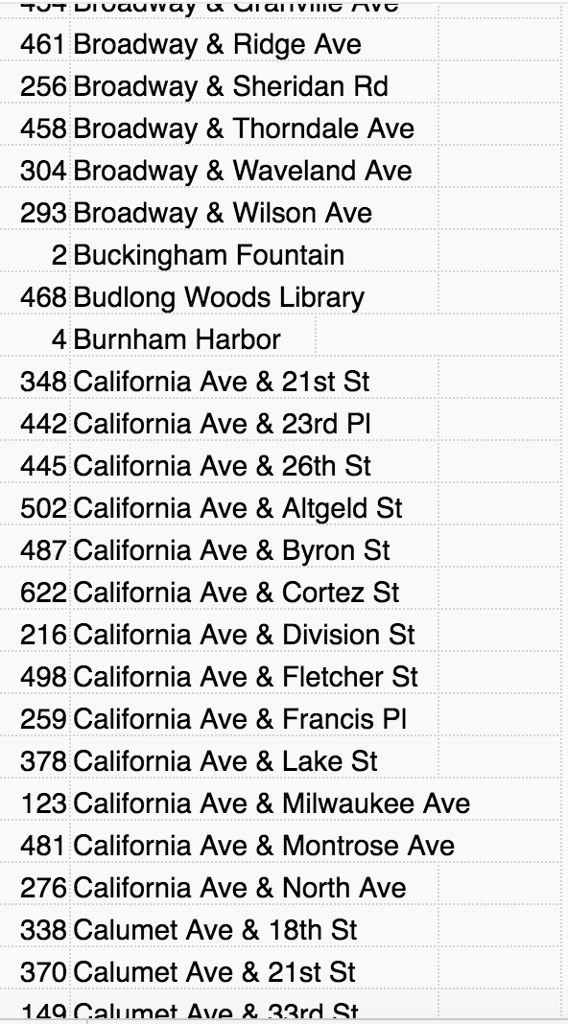
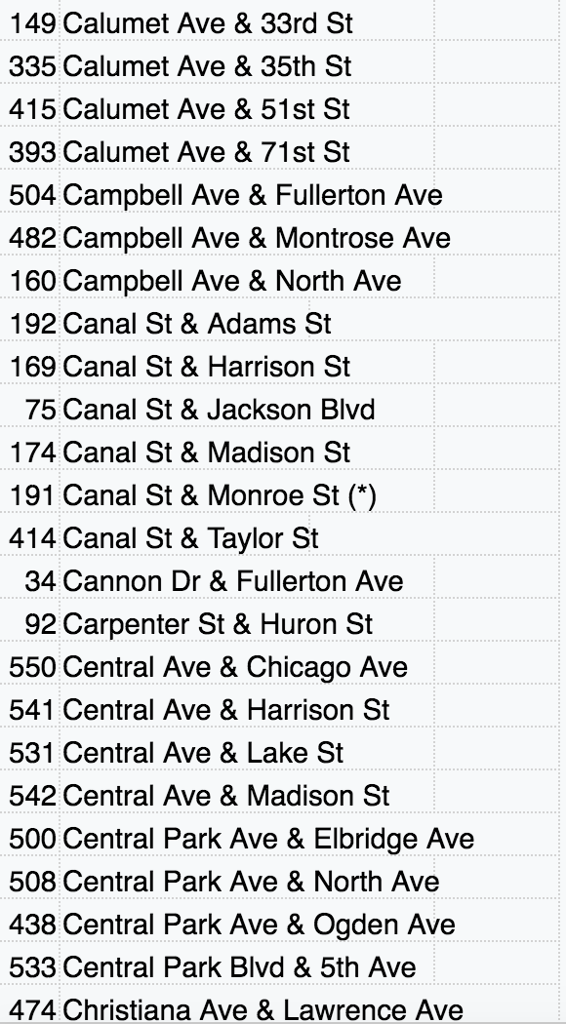

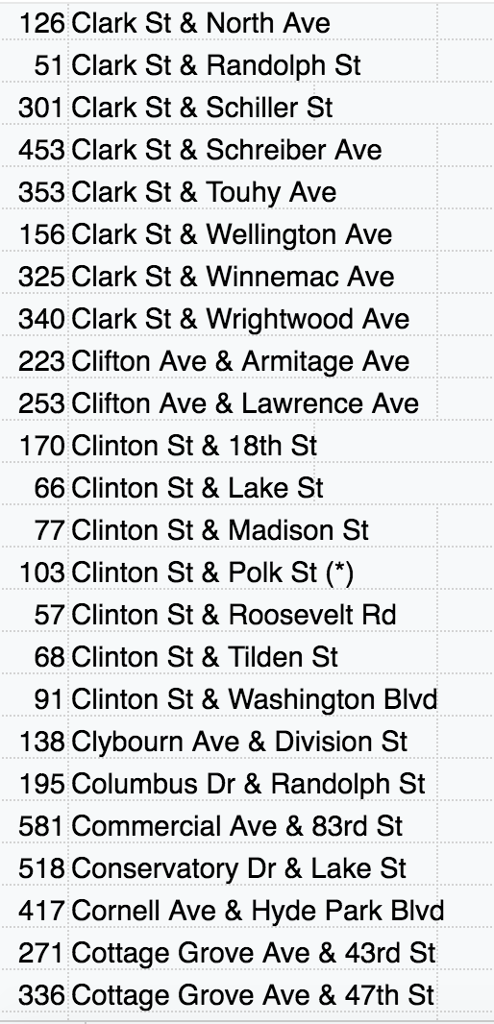
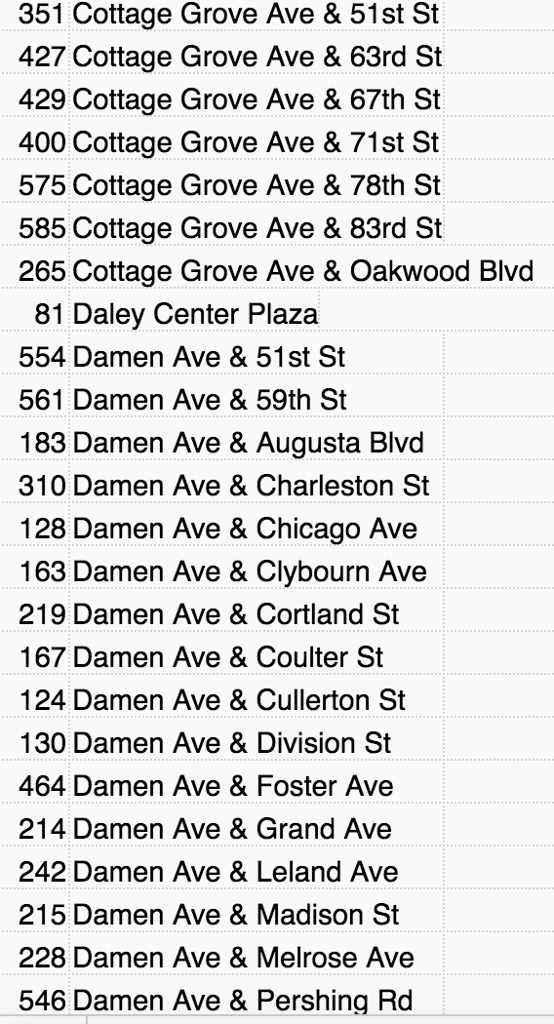
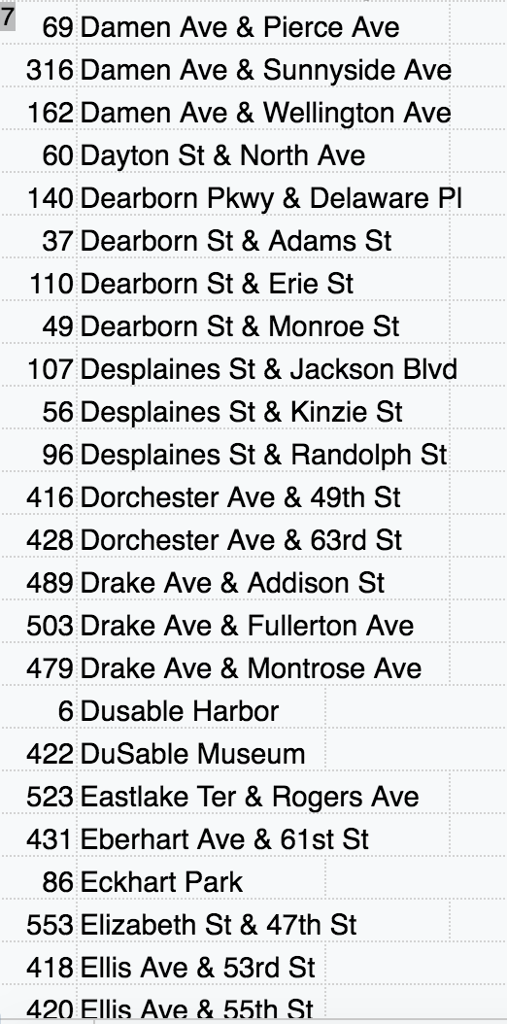
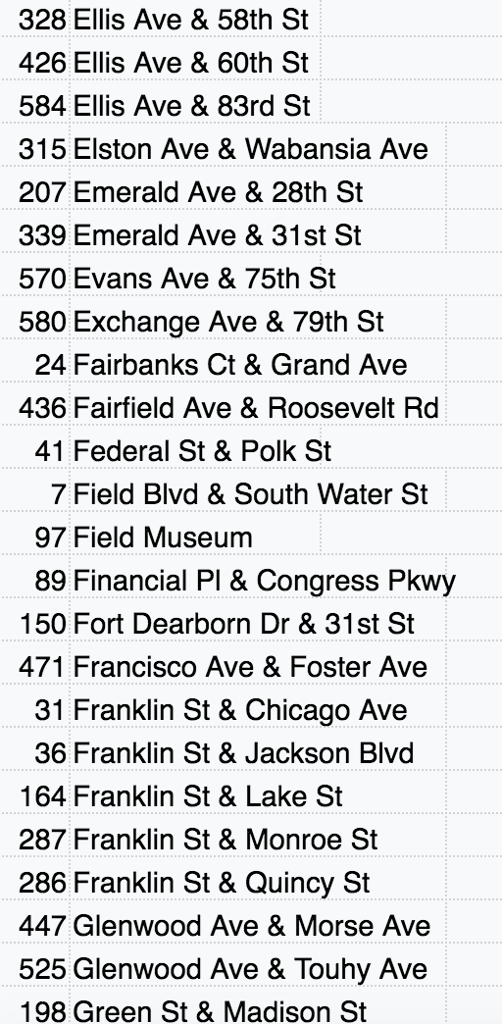
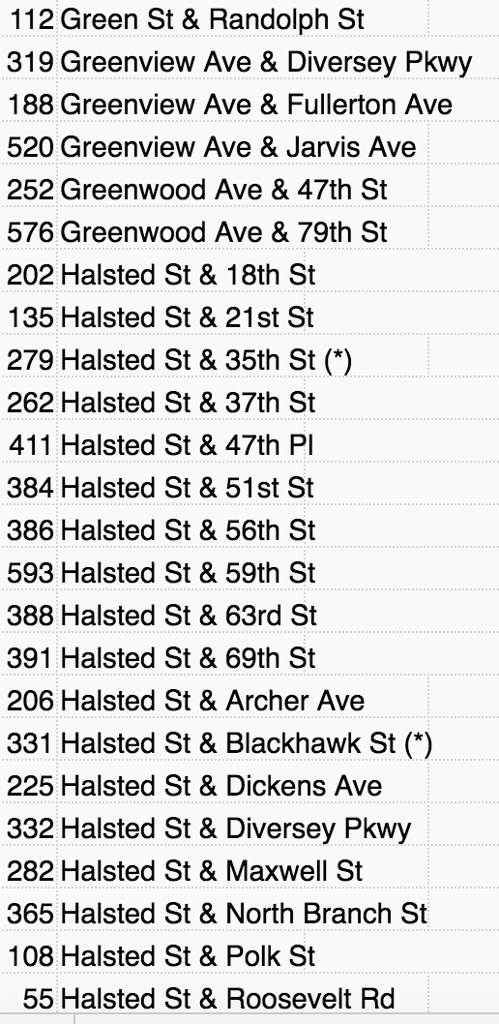
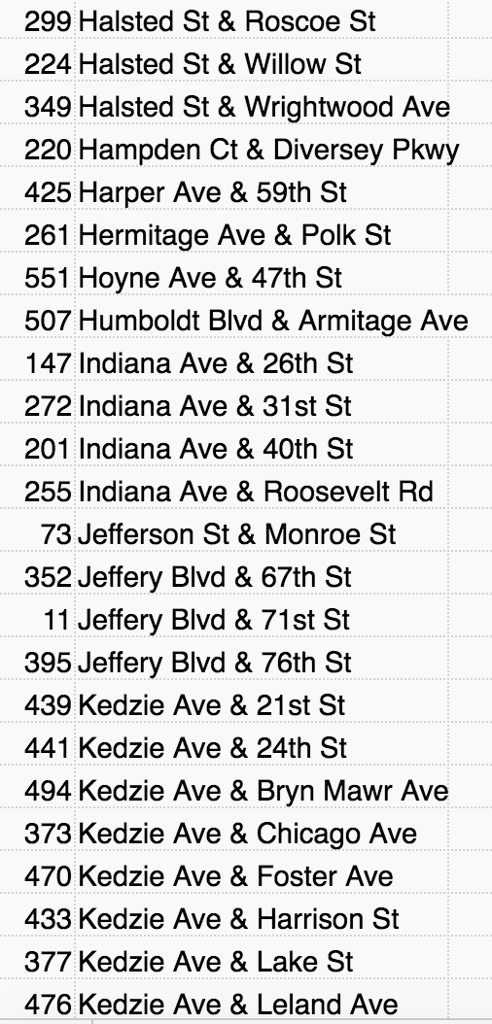

%%
%% GetStationName
%%
%% Given a Divvy station id, loads the Divvy file 'divvy-stations.csv'
%% and returns the station name associated with this id. Returns
%% the string 'Station not found...' if the given station id is not
%% found.
%%
%% NOTE: you must pass a single id, you cannot pass a vector of ids.
%%
%%
%% Prof. Joe Hummel
%% U. of Illinois, Chicago
%% CS109, Spring 2018
%% Project #13
%%
%%
function Name = GetStationName(id)
filename = 'divvy-stations.csv';
if exist(filename, 'file') ~= 2 %% doesn't exist:
fprintf('**Error in GetStationName: cannot find "divvy-names.csv" file ');
Name = '?';
return;
end
%% load file of station names, and search for matching id:
%% this works in MATLAB or Octave
[IDs, Names] = textread(filename, '%d %s', 'delimiter', ',');
LI = (IDs == id);
if sum(LI) == 1 %% found it!
I = find(IDs == id); %% find index of station id
Name = Names{I}; %% use { } to extract from CELL ARRAY
else
Name = 'Station not found...';
end
end
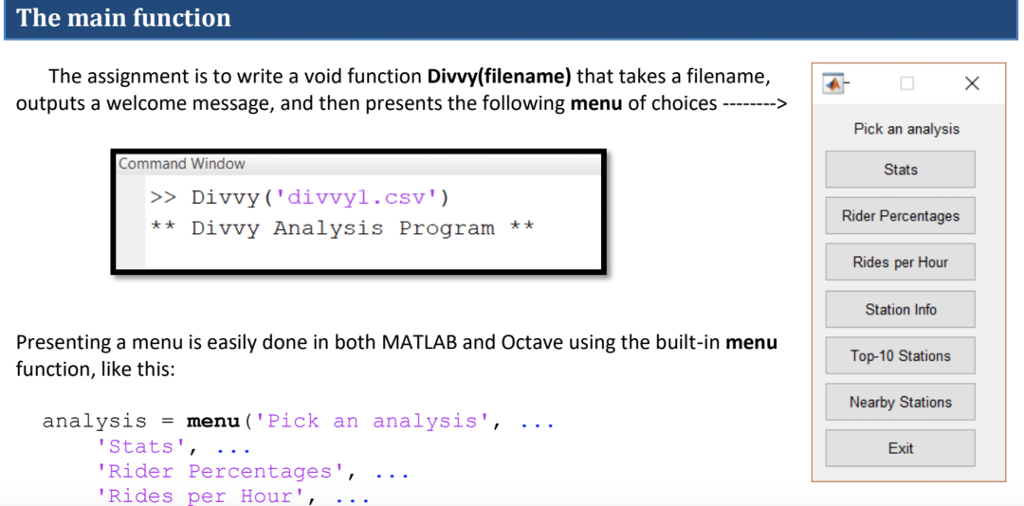
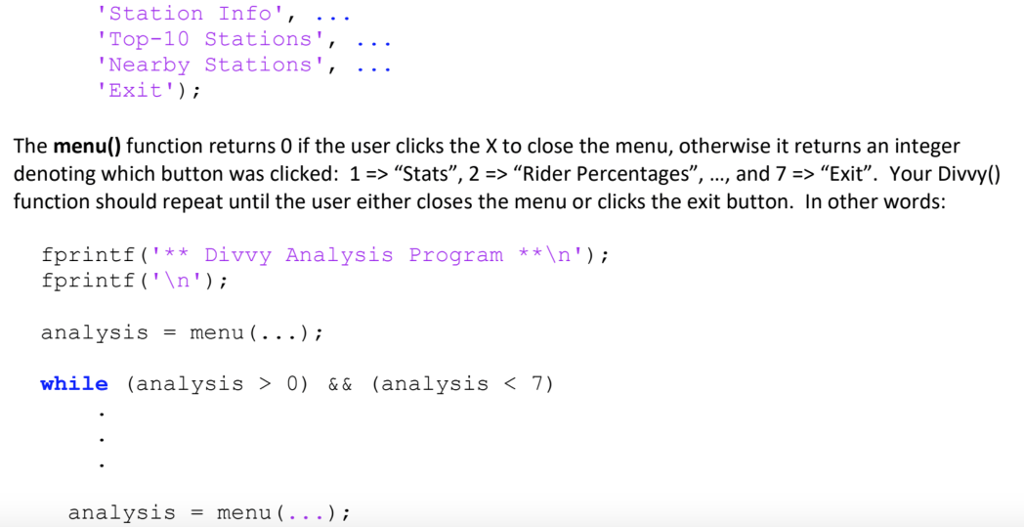
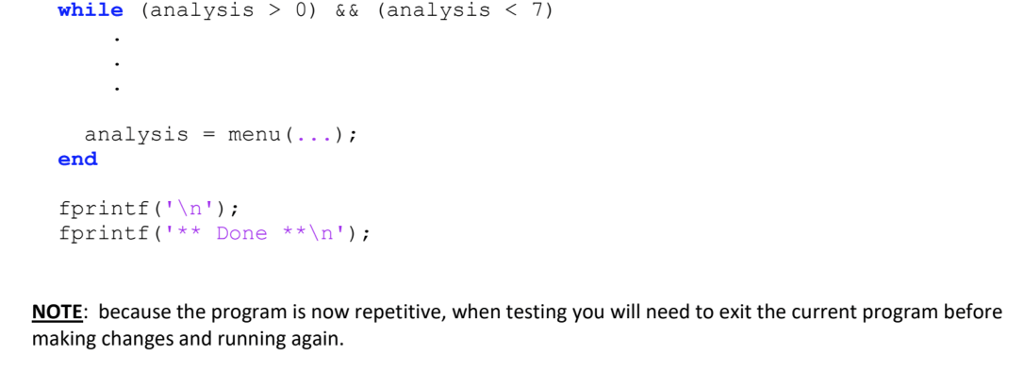
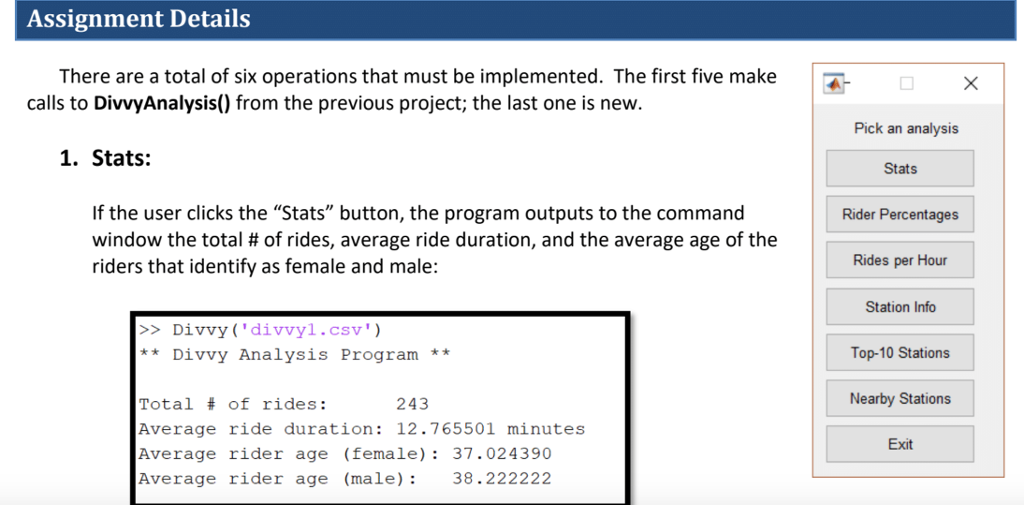

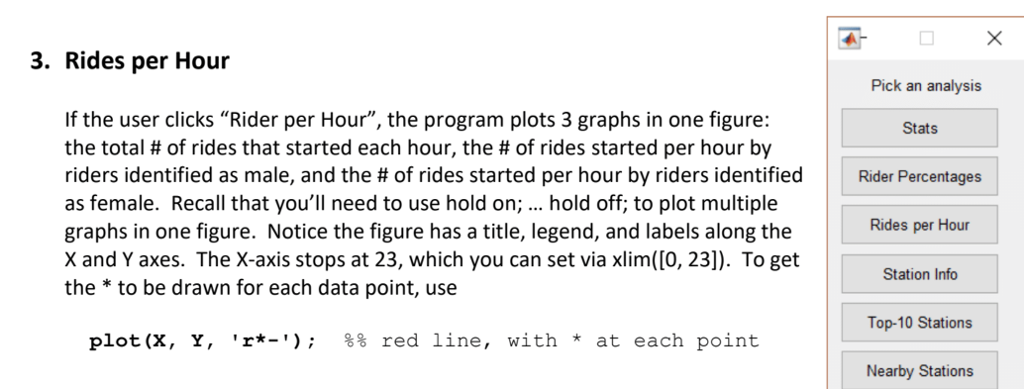
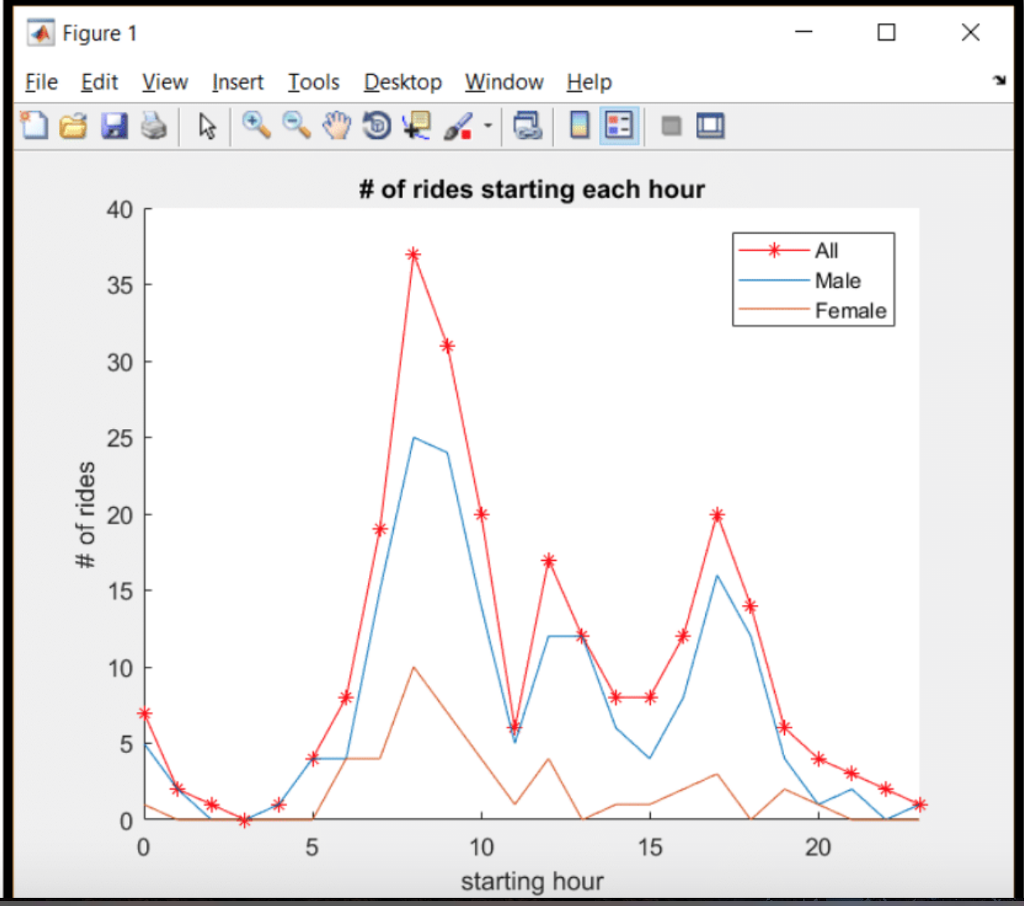
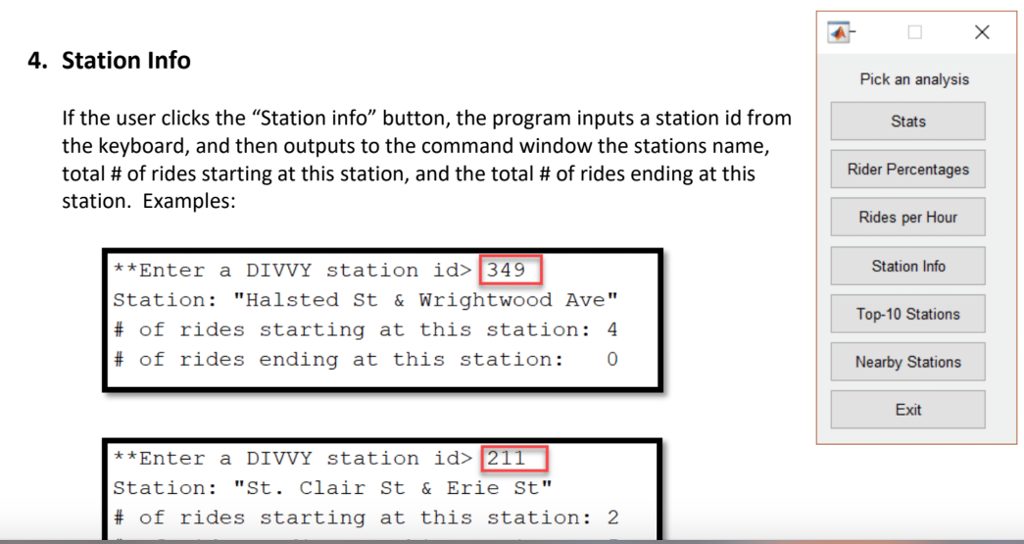
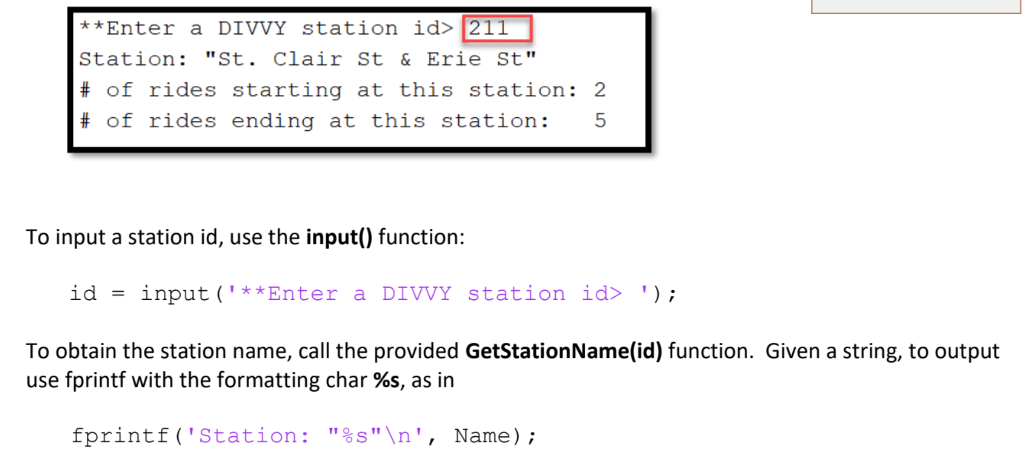
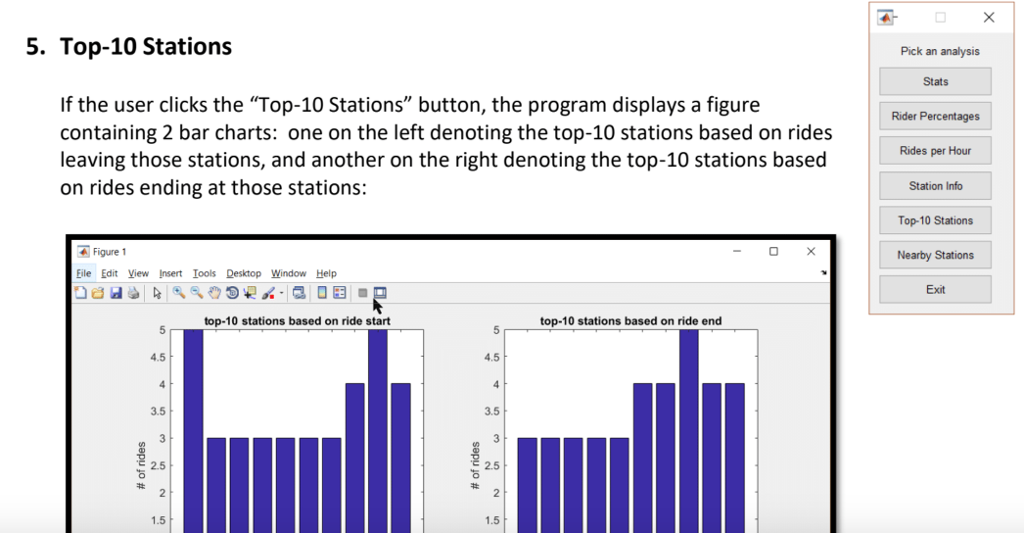

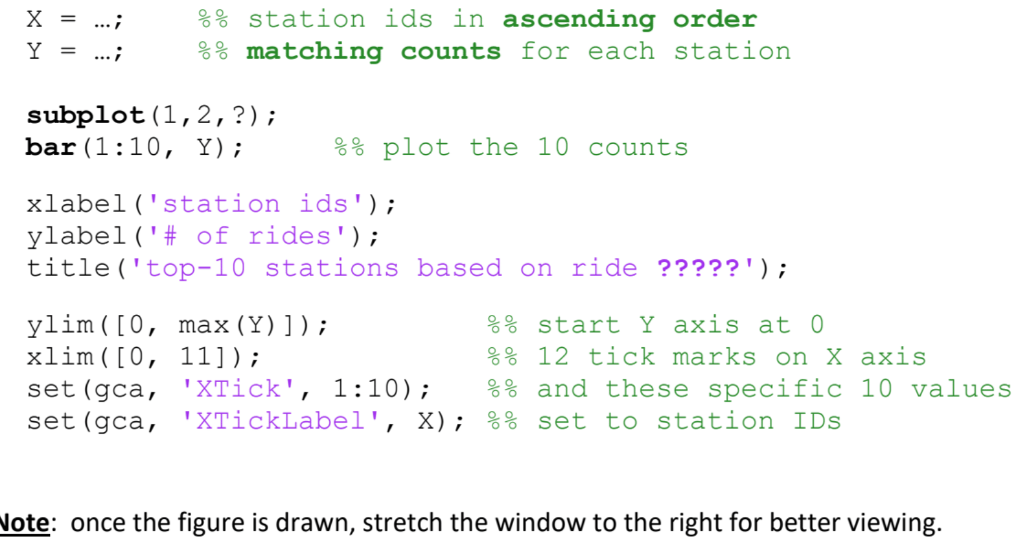
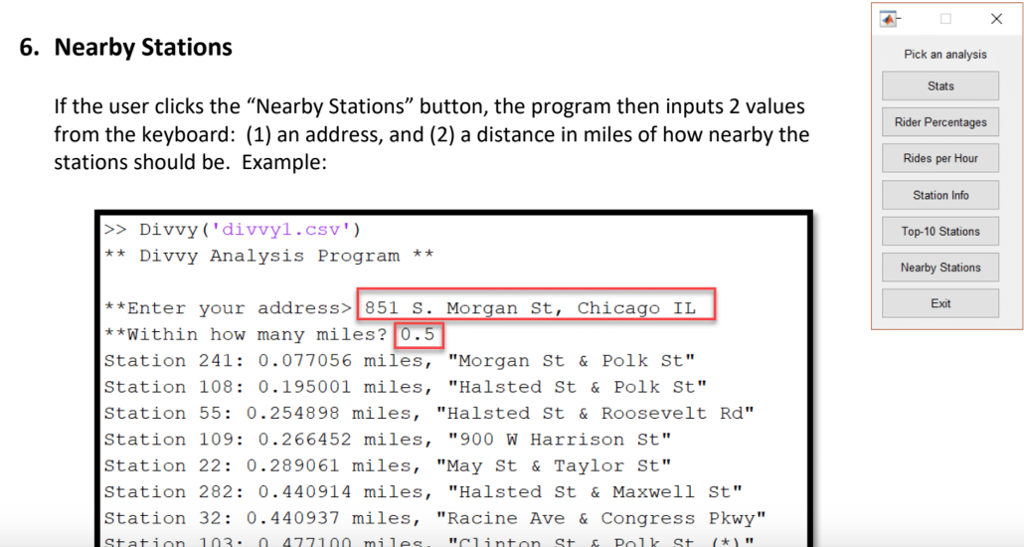
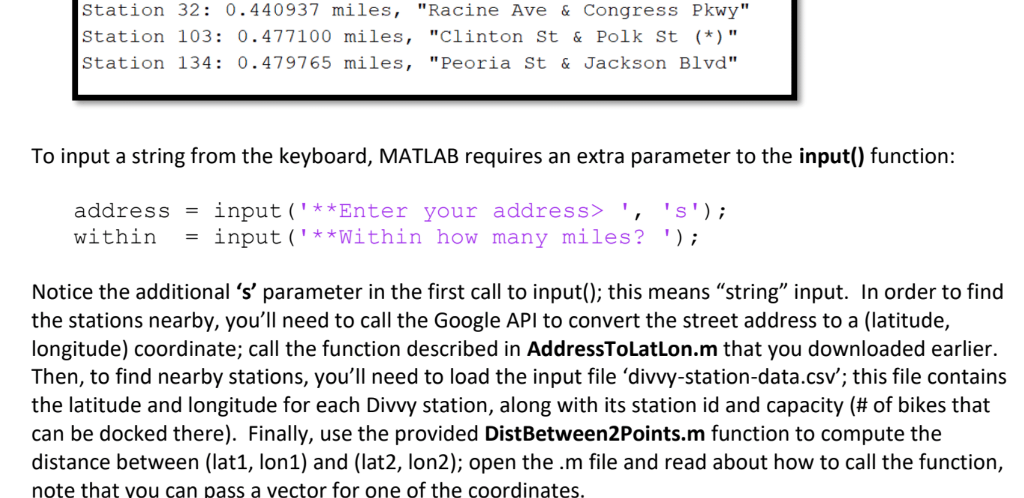

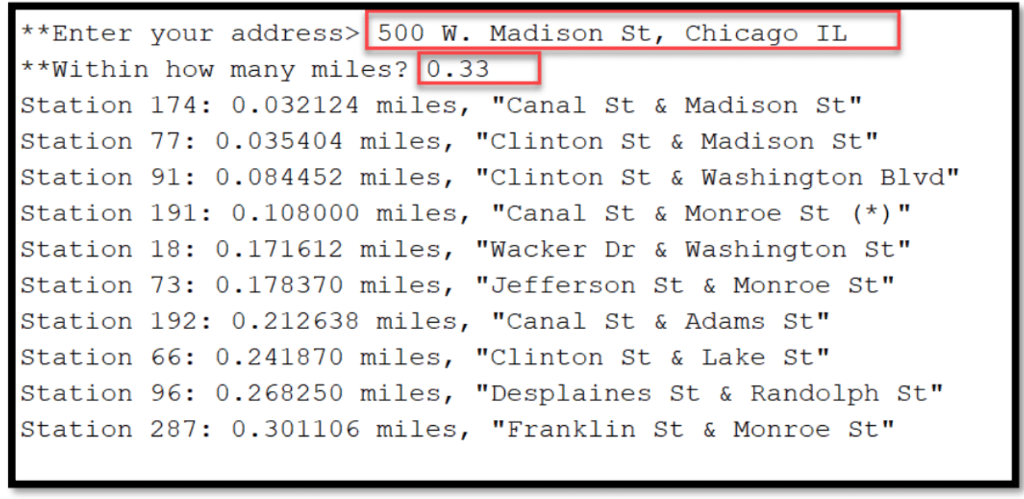
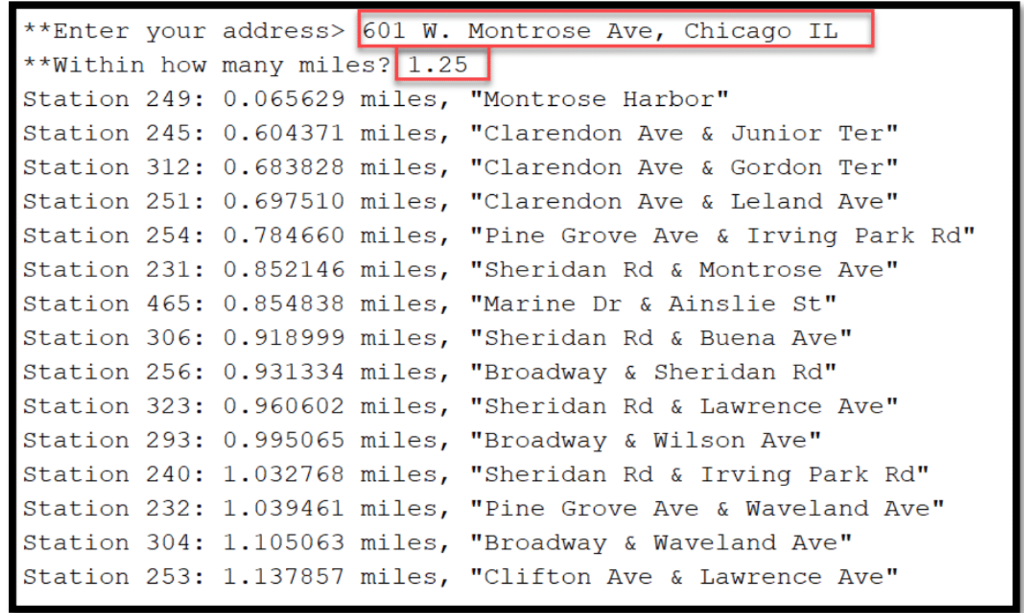
Step by Step Solution
There are 3 Steps involved in it
Step: 1

Get Instant Access to Expert-Tailored Solutions
See step-by-step solutions with expert insights and AI powered tools for academic success
Step: 2

Step: 3

Ace Your Homework with AI
Get the answers you need in no time with our AI-driven, step-by-step assistance
Get Started


